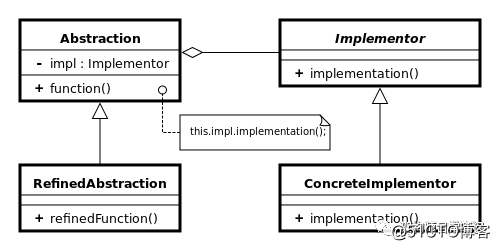标签:相对 场景 sse gap rate img soft ram 使用
其实不需要3分钟,3秒钟就够了,记住桥接模式就是如此简单:一句话,笔有千般形,画有万变化。
下面的仅仅助于理解。
The bridge pattern is a design pattern used in software engineering which is meant to "decouple an abstraction from its implementation so that the two can vary independently"
From Wikipedia, the free encyclopedia:http://en.wikipedia.org/wiki/Bridge_pattern
应用场景
The bridge pattern is useful when both the class as well as what it does vary often。
例如用笔作画,笔有铅笔、钢笔、毛笔、水笔、电脑等;图形有:直线、圆、三角形、树叶等等。各自独立变化。

The following Java (SE 6) program illustrates the ‘shape‘ example given below.
简单描述就是笔和图形的关系:
笔有铅笔、钢笔、毛笔、水笔等等;图形有:直线、圆、三角形、树叶等等。各自独立变化。
/** "Implementor" */
interface DrawingAPI {
public void drawCircle(double x, double y, double radius);
}
/** "ConcreteImplementor" 1/2 */
class DrawingAPI1 implements DrawingAPI {
public void drawCircle(double x, double y, double radius) {
System.out.printf("API1.circle at %f:%f radius %f\n", x, y, radius);
}
}
/** "ConcreteImplementor" 2/2 */
class DrawingAPI2 implements DrawingAPI {
public void drawCircle(double x, double y, double radius) {
System.out.printf("API2.circle at %f:%f radius %f\n", x, y, radius);
}
}
/** "Abstraction" */
abstract class Shape {
protected DrawingAPI drawingAPI;
protected Shape(DrawingAPI drawingAPI){
this.drawingAPI = drawingAPI;
}
public abstract void draw(); // low-level
public abstract void resizeByPercentage(double pct); // high-level
}
/** "Refined Abstraction" */
class CircleShape extends Shape {
private double x, y, radius;
public CircleShape(double x, double y, double radius, DrawingAPI drawingAPI) {
super(drawingAPI);
this.x = x; this.y = y; this.radius = radius;
}
// low-level i.e. Implementation specific
public void draw() {
drawingAPI.drawCircle(x, y, radius);
}
// high-level i.e. Abstraction specific
public void resizeByPercentage(double pct) {
radius *= pct;
}
}
/** "Client" */
class BridgePattern {
public static void main(String[] args) {
Shape[] shapes = new Shape[] {
new CircleShape(1, 2, 3, new DrawingAPI1()),
new CircleShape(5, 7, 11, new DrawingAPI2()),
};
for (Shape shape : shapes) {
shape.resizeByPercentage(2.5);
shape.draw();
}
}
}It will output:
API1.circle at 1.000000:2.000000 radius 7.5000000
API2.circle at 5.000000:7.000000 radius 27.500000
无聊加入下面的文字,凑够博客园的文字篇幅要求,不用看。
Bridge 模式是构造型的设计模式之一。Bridge模式基于类的最小设计原则,通过使用封装,聚合以及继承等行为来让不同的类承担不同的责任。它的主要特点是把抽象(abstraction)与行为实现(implementation)分离开来,从而可以保持各部分的独立性以及应对它们的功能扩展。
面向对象的程序设计(OOP)里有类继承(子类继承父类)的概念,如果一个类或接口有多个具体实现子类,如果这些子类具有以下特性:
标签:相对 场景 sse gap rate img soft ram 使用
原文地址:https://blog.51cto.com/15015181/2556806